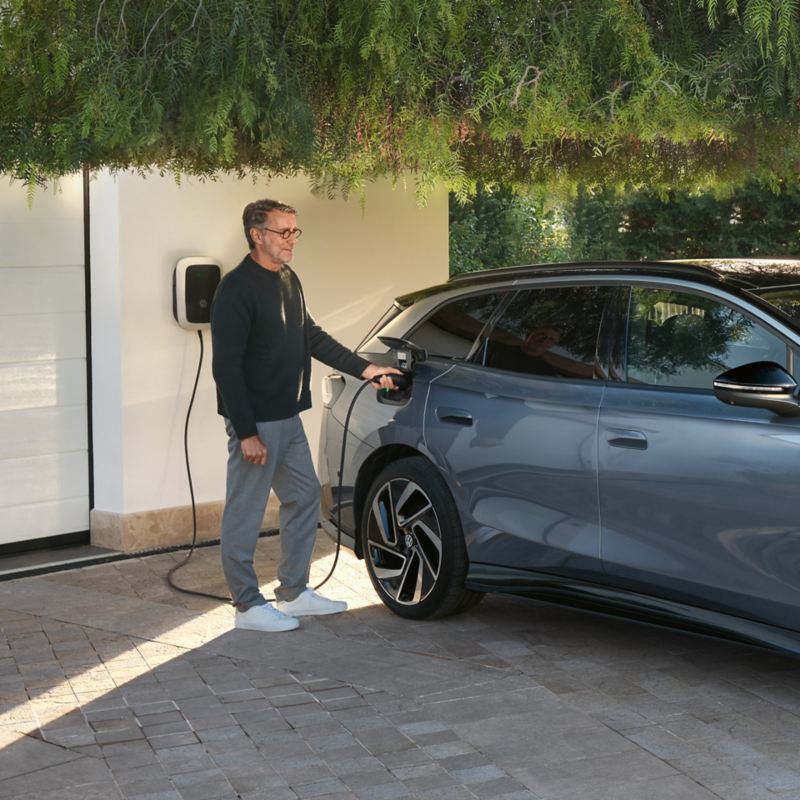What kind of motor does an electric car have?
In electric cars and plug-in hybrids, electric motors convert the electrical energy stored in the lithium-ion battery into mechanical power. A system like this always consists of three components: the battery, the power electronics, and the motor. All three together determine the performance of the car.
Electric motors in electric cars ...
- are efficient
- convert electricity into motion
- can recover kinetic energy
Anyone driving an electric car for the first time will likely be surprised by the almost total lack of engine noise. It’s because in place of the combustion engine, one or more electrical machines guarantee a whisper-quiet driving experience: electric motors. As the electric drive is so quiet that it can barely be heard outside the electric vehicle, an exterior speaker emits an artificial sound up to a speed of around 18mph to let other road users know you’re there.
Apart from the battery and power electronics, electric motors are the very beating heart of every electric vehicle. The harmonious interplay of these components also determines the range of the vehicle. Electric motors are regarded as pioneering as they are extremely efficient and, unlike combustion engines, they consume no fossil fuels.
A major benefit of e‑mobility is that electric motors produce no exhaust gases, such as CO2 or nitrogen oxides, making them locally CO2-free to drive.
How an electric motor works: attraction and repulsion forces
You need to move to get from A to B. That is precisely what the electric motor does, by using the attraction and repulsion forces that magnetic fields exert on each other.
An electric motor usually consists of a stationary stator and an inner part rotating within it, known as the rotor. Both parts have coils carrying current that each generate a magnetic field. The orientation of the alternately repelling and attracting magnetic fields (north/south poles) depends on the direction of the current.
Repeatedly reversing the polarity of the coils during a revolution of the rotor causes the rotor to rotate continuously. This rotation is used to drive the wheels of the car – this is the principle of electric driving.
No need for a complex gearbox – high torque from a standing start
Electric motors can be used within a much wider speed range than internal combustion engines. Maximum torque is available from a standing start, providing full impressive traction right away. This explains why models with an electric drive do not need a clutch or a gearbox. Generally, an efficient reduction gear with a fixed ratio (only one gear) is used. What is more, as electric machines can move in both directions, electric cars don’t necessarily need a separate reverse gear.

The electric motor in an electric vehicle – low maintenance and efficient
Electric car drivers do not need to bother with regular oil changes or replacing drive belts. The vehicle's regenerative energy function also ensures that brake discs and pads are exposed to less stress in electric cars. The maintenance can therefore be a lot simpler than that of a comparable combustion engine model.
Electric motors lose very little energy as they are extremely low friction and heat up less than combustion engines. Electric vehicle motors are extremely efficient – with calculated values ranging from around 80 to over 90 percent efficiency. This means that very little of the energy fed in is not used for forward motion. The efficiency is a physical variable and describes the relationship between the energy fed in and used.
Synchronous or asynchronous – not all electric motors are identical
Today, modern electric vehicles have synchronous or asynchronous motors fitted. The difference lies in the way the rotor works: in a synchronous motor, the rotor follows the rotating magnetic field of the stator at the same rate – synchronously. By contrast, in an asynchronous motor, the rotor follows the stator with a delayed action, hence asynchronously.
Synchronous motors have the benefit of higher power and torque density. The design of asynchronous motors is somewhat simpler and so cheaper to manufacture – also partly because their production does not require any rare-earth materials and the control electronics are less complex. However, electric vehicles of this kind are less efficient and are larger and heavier.
The PSM permanent magnet synchronous motor
Permanent magnet synchronous motors are often used in electric cars. The Volkswagen ID.3 is also powered by a PSM (permanent magnet synchronous motor). Its key strength is its efficiency – significantly over 90 percent in most driving situations.
The power electronics convert the direct current from the lithium-ion battery into a three-phase current for the electric motor and do the opposite during recovery when it functions as a generator. The Volkswagen PSM is compact and comparatively light, with the motor block weighing less than 90 kilogrammes including the gearbox and power electronics.
Volkswagen uses innovative technology in its production: flat, nested pre-formed copper coils deliver high batch quantities, at the same time-saving space in the body.
Everything is possible: front, rear, or four-wheel drive
Unlike a combustion engine vehicle, electric cars can have four-wheel drive without the need for a Cardan shaft to connect the two axles. An electric motor on each axle is all that is needed to get the car moving. This is known as dual-motor all-wheel drive – as is fitted in the ID.4 GTX
Single-wheel drive is another technical option for achieving a 4x4 drive. Here, each wheel is driven individually by an electric motor. The key feature here is that the driving force can be distributed very precisely and as required. This technology could be of real interest in the future for electric sports cars and off-road SUVs.




